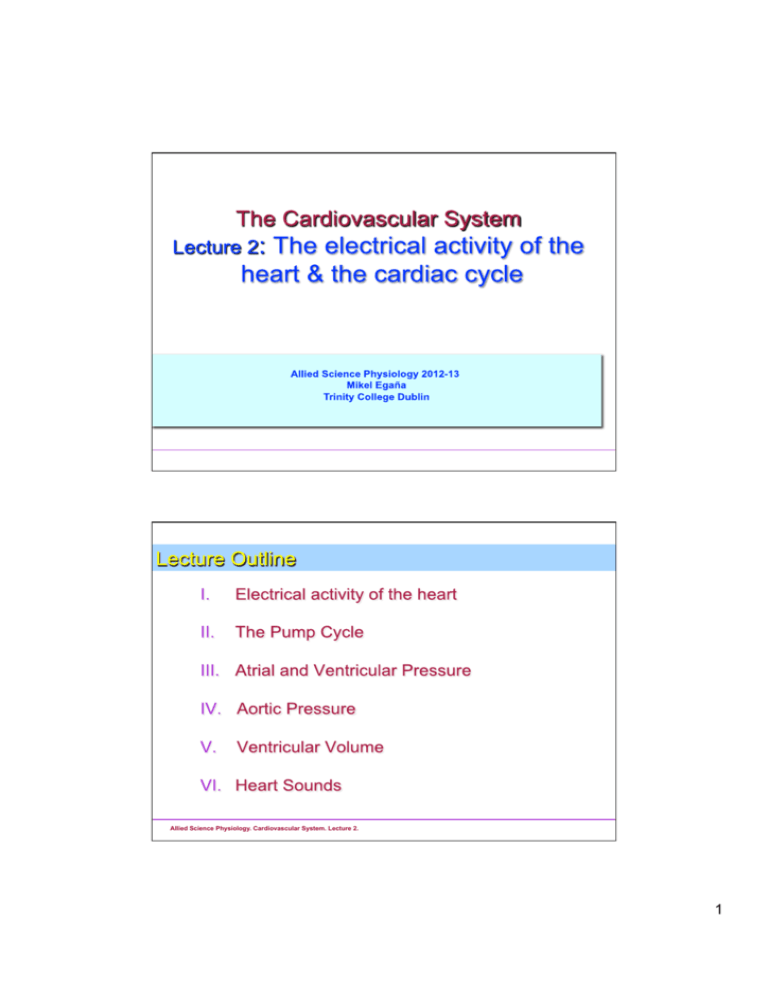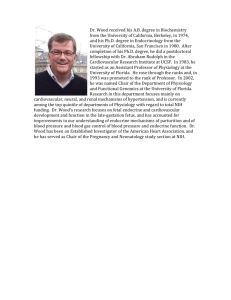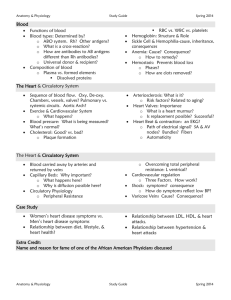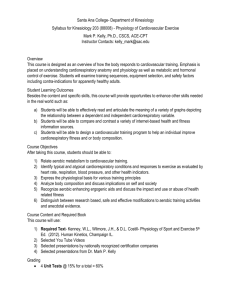CV Lecture 2
advertisement

Allied Science Physiology 09-10. Cardiovascular System. Lecture 3. Allied Science Physiology. Cardiovascular System. Lecture 2. 1 Allied Science Physiology. Cardiovascular System. Lecture 2. • Cardiac muscle doesn’t require commands from the CNS to contract • Contractile activity of cardiac muscle: myogenic • Autorhythmicity is the ability to generate its own rhythm • Autorhythmic cells that provide rhythm to the heartbeat. 2 types – Pacemaker cell: initiate AP’s – Conduction fibers: transmit AP’s Allied Science Physiology. Cardiovascular System. Lecture 2. 2 • Pacemaker cells – Spontaneously depolarizing membrane potentials to generate action potentials – Coordinate and provide rhythm to heartbeat • Conduction fibers – Rapidly conduct action potentials initiated by pacemaker cells to myocardium – Conduction velocity = 4 meters/second – Ordinary muscle fibers, CV = 0.4 meter/second Allied Science Physiology. Cardiovascular System. Lecture 2. • Sinoatrial node (SA node): 70-80 APs/min – Pacemaker of the heart • Atrioventricular node (AV node): 40-60 APs/min • Internodal pathways • Bundle of His: 20-40 APs/min • Purkinje fibers: 20-40 APs/min Allied Science Physiology. Cardiovascular System. Lecture 2. 3 • Atria contract first followed by ventricles (fibrous skeleton) • Coordination due to presence of gap junctions and conduction pathways Figure 13.9 Allied Science Physiology. Cardiovascular System. Lecture 2. Figure 13.10 Allied Science Physiology. Cardiovascular System. Lecture 2. 4 • Interatrial Pathway – SA Node right atrium left atrium – Simultaneous contraction right and left atria • Internodal Pathway: SA Node AV Node – Slow conduction - AV Nodal Delay = 0.1 sec – Atria contract before ventricles • Ventricular Excitation (fast conduction) – Down Bundle of His – Up Purkinje Fibers • Purkinje Fibers contact ventricle contractile cells • Ventricle contracts from apex up Allied Science Physiology. Cardiovascular System. Lecture 2. Figure 13.11 Allied Science Physiology. Cardiovascular System. Lecture 2. 5 • ECG is used to look at some aspects of cardiac electrical activity • Non-invasive technique • Used to test for clinical abnormalities in conduction of electrical activity in the heart • Body fluids are conductors • Currents in the body can spread to surface Allied Science Physiology. Cardiovascular System. Lecture 2. • P wave: atrial depolarization • QRS complex: vent. depolarization • T wave: vent. repolarization • P-R: AV node conduction time • R-T: vent. contraction (systole) • T-Q: vent. relaxation (diastole) • R-R: time between heart beats Figure 13.16b Allied Science Physiology. Cardiovascular System. Lecture 2. 6 Allied Science Physiology. Cardiovascular System. Lecture 2. All the events associated with the flow of blood through the heart during a single complete heartbeat (approx 0.8sec if heart rate is 75bpm) 2 Main periods of cardiac cycle (72 beats/min) • Systole (0.3 s) – Ventricle contraction • Diastole (0.5 s) – Ventricle relaxation Allied Science Physiology. Cardiovascular System. Lecture 2. 7 • Valves open passively due to pressure gradients – AV valves open when • P atria > P ventricles – Semilunar valves open when • P ventricles > P arteries Allied Science Physiology. Cardiovascular System. Lecture 2. Phase 1: Ventricular filling (Venous return and atrial contraction) – Blood returns to the heart via systemic and pulmonary veins – AV valves open (Pressure atria > Pressure ventricles) – Passive phase - no atria or ventricular contraction – Sharp volume increase; levels off as pressure gradient decreases – Active phase - atria contract – Pressure in ventricle increases because extra blood is forced in – Volume in ventricle increases Allied Science Physiology. Cardiovascular System. Lecture 2. 8 Phase 2: Isovolumetric ventricular contraction – Ventricle contracts - increases pressure – AV valve shut (pressure in ventricle > pressure in atria) – Semilunar valve still closed – No blood entering or exiting ventricle (isovolumetric) Allied Science Physiology. Cardiovascular System. Lecture 2. Phase 3: Ventricular ejection – Ventricles continue to contract – Semilunar valves open (Pressure ventricles > Pressure aorta) – Pressure continues to increase in ventricles: peaks then declines – Aortic pressure increases: peaks then declines – Blood volume decreases as ejection occurs Allied Science Physiology. Cardiovascular System. Lecture 2. 9 Phase 4: Isovolumetric Ventricular Relaxation – Ventricle relaxes - decreases pressure – Ventricular pressure drops as ventricle relaxes – Aortic pressure decreases as pressure dissipates through arterial system – Semilunar valve closes – Semilunar and AV valves are closed – no blood movement – no volume change Allied Science Physiology. Cardiovascular System. Lecture 2. Figure 13.18 Allied Science Physiology. Cardiovascular System. Lecture 2. 10 • Isovolumetric Ventricular Contraction – AV & aortic valves closed – Ventricular pressure increases until it exceeds atrial pressure • Ventricular Ejection – Aortic valve opens – Blood moves from ventricle to aorta Allied Science Physiology. Cardiovascular System. Lecture 2. • Isovolumetric Ventricular Relaxation – Ventricle muscle relaxes so that pressure is less than aorta – Aortic valve closes – Pressure in ventricle continues dropping until it is less than atrial pressure • Ventricular Filling – AV valve opens – Blood moves from atria to ventricle – Passive until atrium contracts Allied Science Physiology. Cardiovascular System. Lecture 2. 11 Figure 13.18 Allied Science Physiology. Cardiovascular System. Lecture 2. Figure 13.19 Allied Science Physiology. Cardiovascular System. Lecture 2. 12 • Rises and falls with each heartbeat: blood flow is pulsatile • Normal value for systolic pressure is approx. 120mmHg • Normal value for diastolic pressure is approx. 80mmHg • Pulse pressure = Systolic – diastolic = approx. 40mmHg • Average aortic pressure throughout the cardiac cycle is called mean arterial pressure – very important (later lecture) Figure 13.20 Allied Science Physiology. Cardiovascular System. Lecture 2. • Aorta (and large arteries) – elastic – Pressure reservoir • Store energy during systole as walls expand • Release energy during diastole as walls recoil inward • Maintains blood flow through entire cardiac cycle Allied Science Physiology. Cardiovascular System. Lecture 2. 13 • EDV = end diastolic volume = volume of blood in ventricle at end of diastole • ESV = end systolic volume = volume of blood in ventricle at end of systole • SV = stroke volume = volume of blood ejected from heart each cycle = SV = EDV - ESV (130 mL – 60 mL = 70 mL) • Ejection fraction: Fraction of end-diastolic volume ejected during a heartbeat. Ejection fraction = stroke volume / end diastolic volume = 70 mL / 130 mL = 0.54 Figure 13.21 Allied Science Physiology. Cardiovascular System. Lecture 2. Sounds occur due to: First sound = soft lubb AV valves close Second sound = louder dubb Semilunar valves close Sounds also referred to as ‘lup’ and ‘dup’ Figure 13.22 Allied Science Physiology. Cardiovascular System. Lecture 2. 14 • ECG = measure of electrical events • Electrical events cause mechanical events, so precede mechanical events – P wave precedes atrial contraction – QRS complex precedes ventricular contraction – T wave precedes ventricular relaxation Figure 13.18 Allied Science Physiology. Cardiovascular System. Lecture 2. 15







